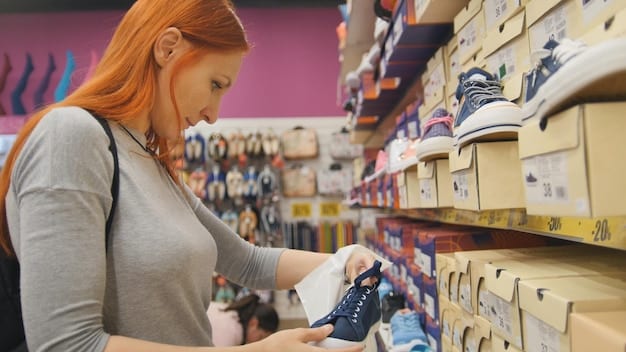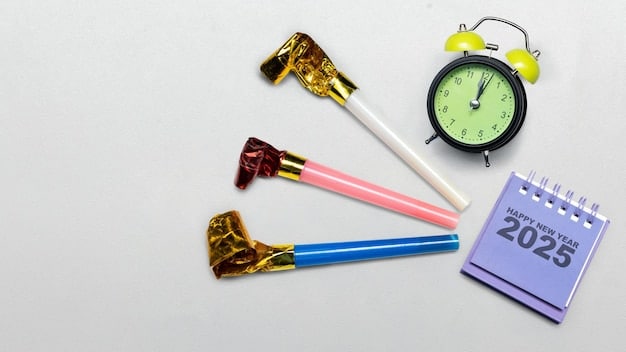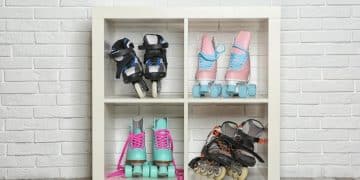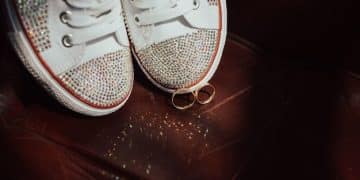Collect Sneakers on a Budget: Build Your Dream $500 Collection

Achieving a stylish and varied sneaker collection is entirely possible on a $500 budget by focusing on strategic purchases, understanding market trends, and prioritizing quality and versatility over hype.
Embarking on the journey of sneaker collecting for beginners: building your dream collection on a $500 budget can seem daunting. Many perceive this hobby as an exclusive pursuit reserved for those with deep pockets and an insatiable appetite for rare, high-value releases. However, with a strategic approach, a keen eye for value, and a commitment to smart shopping, it is entirely possible to curate a noteworthy collection without breaking the bank.
Understanding the Market: Value vs. Hype
When starting a sneaker collection, especially with a limited budget, it’s crucial to distinguish between fleeting hype and enduring value. Many newcomers are drawn to the latest releases that dominate social media, often fetching exorbitant resale prices. While these might offer instant gratification, they rarely align with a $500 budget and don’t always represent the best long-term investment or versatile style.
True value in sneaker collecting often lies in classic silhouettes, collaborations that offer a unique twist on established models, or well-executed general releases that provide comfort and style without the inflated price tag. Learning to recognize these opportunities is foundational for a beginner on a budget.
The Allure of Evergreen Styles
Certain sneakers transcend trends, remaining relevant and stylish year after year. These “evergreen” styles are often produced in larger quantities, making them more accessible and affordable. They form the backbone of any versatile collection.
- Iconic Silhouettes: Models like the Adidas Stan Smith, Nike Air Force 1, or Converse Chuck Taylor have stood the test of time.
- Versatility: Often available in neutral colorways, making them easy to pair with various outfits.
- Consistent Availability: Less prone to dramatic price fluctuations or limited releases.
Focusing on these foundational pieces allows you to build a solid wardrobe before venturing into more niche or expensive selections. They offer a high return on investment in terms of wearability and timeless appeal.
Hype, on the other hand, is driven by scarcity and marketing. Limited releases and celebrity endorsements can artificially inflate prices. While participating in the hype can be exciting, it’s a risky game for beginners on a budget. These pickups often demand immediate attention but lose their appeal as new trends emerge.
Developing an understanding of the secondary market is also critical. Platforms like StockX, GOAT, and eBay are essential for finding deals, but they also reflect the inflated prices of hyped items. Learning to navigate these platforms, recognizing authentic sellers, and setting price alerts for desired models can reveal hidden gems within your budget.
Prioritizing personal style over popular opinion is a cornerstone of smart collecting. A sneaker that aligns with your individual aesthetic will provide more satisfaction and utility than one bought solely because it was trending. This mindset shift is vital for building a cohesive and personally fulfilling collection within your financial constraints.
Setting Your Budget: Maximizing Each Dollar
The $500 budget is your guiding principle, and every dollar must be accounted for. It’s not just about the sticker price of the sneakers, but also considering potential shipping costs, taxes, and any necessary cleaning or maintenance supplies. A disciplined approach to spending is key to preventing overruns and ensuring you get the most out of your investment.
Rather than viewing $500 as a limit, consider it a strategic allocation of resources. This budget discipline encourages creativity and smart decision-making, forcing you to prioritize quality, versatility, and personal relevance over impulse buys or fleeting trends. It shifts the focus from quantity to curated selections.
Strategic Allocation and Research
Before making any purchase, a clear plan is essential. Instead of randomly buying a pair, consider what gaps exist in your current wardrobe and what types of sneakers would genuinely enhance your style. Do you need a classic white shoe? A comfortable daily beater? Something for specific weather conditions? Categorizing your needs helps guide your spending.
- Identify Your Needs: List the types of sneakers you genuinely need for different occasions or outfits.
- Research Price Points: Understand the average street price for the models you’re interested in. Look for sales, discounts, and second-hand deals.
- Set Price Limits: Decide the maximum you’re willing to pay for each individual pair to stay within the overall $500.
This level of pre-purchase research is not merely about finding the cheapest option; it’s about identifying the best value within your specified budget. This might involve setting price alerts on various retail and resale platforms, waiting for seasonal sales, or exploring lesser-known brands that offer comparable quality at a lower cost.
Consider the “cost per wear” of each potential purchase. A slightly more expensive, durable, and versatile sneaker that you wear frequently might offer better long-term value than a cheaper, less comfortable, or less adaptable pair that sits in your closet. This perspective encourages investing in timeless pieces rather than disposable fashion.
Building relationships with local sneaker stores can also unlock benefits. Sometimes, store employees can offer insights into upcoming sales, tell you about overlooked gems, or perhaps even give you a heads-up on slight defects that can lead to discounts. Every dollar saved on one pair contributes to the overall strength of your collection, allowing you to potentially add another quality item.
Where to Buy: Navigating the Retail Landscape
The sneaker market is vast, encompassing everything from traditional brick-and-mortar stores to online giants and specialized resale platforms. Each avenue offers unique advantages and disadvantages for the budget-conscious collector. Knowing where to look for deals is as important as knowing what to buy.
Your $500 budget necessitates a diverse shopping strategy, combining patience with opportunistic buying. Relying solely on one type of retailer or waiting for specific drops will likely lead to frustration and missed opportunities. A multi-pronged approach will yield the best results.

Online Retailers and Discounts
Major online retailers are often the first stop for many, offering convenience and a wide selection. However, the real savings often come from their sale sections and promotional events.
- Official Brand Websites: Keep an eye on sales sections and sign up for newsletters for exclusive discount codes.
- Large Retailers (e.g., Foot Locker, Finish Line): These often have clearance racks or seasonal sales where you can find great deals on popular models.
- Online Discount Stores (e.g., Zappos, 6PM): Specializing in discounted previous season’s models or overstock, these can be goldmines for new-in-box shoes.
Timing is crucial when shopping online. Black Friday, Cyber Monday, end-of-season sales, and holiday promotions are peak times for finding significant markdowns. Setting up notifications for specific brands or models you’re interested in can give you a crucial edge.
Beyond new releases, the pre-owned market offers immense value. Platforms like GOAT, StockX, eBay, and even local Facebook Marketplace groups can provide access to gently used or even deadstock (new, unworn) sneakers at a fraction of their retail price. However, caution is advised here to avoid fakes and ensure the condition matches the description.
When buying pre-owned, always request detailed photos, especially of the soles, insoles, and any potential flaws. Verify the seller’s reputation and read reviews. Many reputable sellers on these platforms are simply making space or reselling items from their own collections, providing opportunities for budget-minded collectors to score valuable pieces.
Don’t overlook local thrift stores, consignment shops, or even garage sales. While finding pristine condition sneakers is rare, you might stumble upon a diamond in the rough that simply needs a good cleaning or minor restoration. These hidden gems can greatly extend your collection’s diversity without straining your budget.
Building Your First $500 Collection: Strategic Picks
With a $500 budget, the goal isn’t to accumulate the most pairs, but to acquire versatile, stylish, and comfortable sneakers that cover a range of needs. A balanced collection will offer options for different outfits and occasions, ensuring your initial investment provides maximum utility and enjoyment.
Forget the notion of needing a closet full of shoes. A carefully curated selection of 3-5 pairs can offer more versatility and satisfaction than a dozen impulse buys. Each pick should justify its place in your collection by fulfilling a specific role or complementing multiple looks.
The Core Collection Plan (Approximate Cost Breakdown)
Here’s a sample strategy for a $500 budget, focusing on versatility and essential styles. Prices are estimates and can vary with sales and condition (new vs. pre-owned).
- The Everyday Workhorse (~$70 – $100): A comfortable, durable sneaker for daily wear. Think Adidas Gazelle, Nike Killshot 2, or a well-maintained pre-owned pair of a more premium model. Opt for neutral colors like black, white, or gray for maximum versatility.
- The Classic Staple (~$80 – $120): An iconic, timeless silhouette that elevates any casual outfit. Examples include Converse Chuck Taylors, Vans Old Skool, or a lower-end Nike Dunk/Air Force 1 in a general release colorway. These are often available on sale.
- The Sporty/Athleisure Option (~$100 – $150): Something with a performance aesthetic that can be dressed up or down. Consider New Balance 574/996, some Saucony models, or even a basic Adidas UltraBoost if found on deep discount or pre-owned. Focus on comfort and contemporary feel.
- The “Wildcard” / Statement Piece (~$100 – $150): This is where you can express a bit of personality. Perhaps a unique colorway of a common model, a lesser-known collaboration you find on sale, or a well-preserved vintage runner. This shoe should spark joy and offer a distinct look.
This approach prioritizes building a foundation before splurging on single, expensive pairs. Remember, buying pre-owned can stretch your budget significantly, allowing you to acquire higher-tier models that would otherwise be out of reach. Patience and diligent searching are your best allies.
By allocating funds wisely across different categories, you ensure that your nascent collection serves multiple purposes. Each sneaker should complement the others, creating a cohesive rotation rather than a disparate group of shoes. This maximizes variety and utility from a limited budget.
Don’t fall into the trap of buying just to accumulate. Every purchase should be deliberate and contribute positively to your overall collection. Ask yourself: “Does this sneaker fill a gap in my collection? Is it versatile? Is it a good value for the price?” Answering these questions honestly will guide you towards smart choices and away from buyer’s remorse.
Maintenance and Care: Protecting Your Investment
Once you’ve acquired your sneakers, the journey doesn’t end there. Proper maintenance and care are crucial, particularly when operating on a budget. Keeping your existing collection in pristine condition extends its lifespan, preserves its aesthetic appeal, and potentially saves you money on replacement pairs. A well-maintained sneaker collection is a reflection of a discerning collector.
Investing a small amount of time and effort into caring for your sneakers yields significant long-term benefits. This proactive approach ensures your kicks look their best, even if they weren’t the most expensive to acquire. It’s about respecting your investment and maximizing the value of each pair.
Essential Care Tips on a Budget
You don’t need expensive cleaning kits to keep your sneakers fresh. Basic household items can often do the trick.
- Regular Cleaning: A soft brush (an old toothbrush works wonders), mild soap (dish soap mixed with water), and a microfiber cloth are often sufficient for most materials. Clean soles and uppers regularly to prevent dirt buildup.
- Protection Sprays: Consider an affordable water and stain repellent spray for new pairs, especially those made of suede or canvas. This acts as a barrier against spills and dirt.
- Proper Storage: Store sneakers in a cool, dry place away from direct sunlight. Shoe trees (affordable plastic ones are fine) can help maintain shape and absorb moisture. Avoid piling shoes on top of each other.
Rotating your sneakers can also extend their life. Avoid wearing the same pair every day, as this puts more stress on the materials and accelerates wear and tear. Having a few pairs allows you to distribute the wear evenly, giving each shoe time to air out and recover.
Learning basic repair skills can also be invaluable. Small scuffs, loose threads, or minor sole separations can often be fixed with shoe glue or a bit of precise cutting and tucking, preventing them from becoming larger, more costly problems. There are many online tutorials available for simple sneaker repairs.
Additionally, knowing when to retire a pair is important. A sneaker that is beyond repair, or whose functionality is compromised, should be replaced. However, with proper care, you’ll be surprised how long even budget-friendly options can last, allowing you to save for your next strategic addition rather than an urgent replacement.
Expanding Your Collection Smartly
As your initial $500 collection takes shape, you’ll inevitably start looking ahead. The temptation to acquire more will grow, but maintaining a budget-conscious mindset is vital for long-term satisfaction. Expanding smartly means continuing to prioritize quality, versatility, and strategic acquisition over impulse buying.
The beauty of collecting on a budget is the ongoing challenge it presents. It encourages a deeper appreciation for each piece and fosters a thoughtful approach to growth. Rather than a quick grab, each new addition becomes a carefully considered decision.

Long-Term Budgeting and Opportunistic Buying
Don’t view the $500 as a one-time thing. Instead, consider a small, consistent monthly saving specifically for future sneaker purchases. This dedicated fund allows you to capitalize on deals without impacting your primary finances. Whether it’s $20 or $50 a month, a steady stream of funds gives you flexibility.
- Refine Your Tastes: As you wear your current collection, you’ll better understand your preferences for comfort, style, and brands. Use this knowledge to inform future purchases.
- Capitalize on Sales: Continuously monitor sales events at major retailers and brand outlets. Patience often pays off.
- Seasonal Clearance: Out-of-season colorways or models often go on deep discount. If you’re not chasing the latest trends, this can be a goldmine.
Consider the “one in, one out” rule for certain types of sneakers. If you acquire a new pair that serves a similar purpose or aesthetic as an existing one, consider selling or donating the older pair. This helps keep your collection curated, prevents clutter, and can even inject a small amount of cash back into your sneaker fund.
Networking within the sneaker community, even online, can provide valuable insights. Dedicated forums, Facebook groups, and Discord servers often have members who are selling, trading, or sharing information about upcoming sales and deals. Building connections can lead to finding rare gems at friendly prices.
Finally, remember that personal enjoyment is the ultimate goal. A larger collection isn’t necessarily a better collection. Focus on acquiring shoes that you genuinely love, that fit your lifestyle, and that make you feel good when you wear them. This approach ensures that your budget-friendly collection is rich in personal value, well beyond its monetary cost.
Sneaker collecting on a budget is an exercise in creativity and discipline. It proves that passion isn’t dictated by the size of one’s wallet, but by the intelligence and thoughtfulness put into each acquisition.
| Key Aspect | Brief Description |
|---|---|
| 📊 Budget Strategy | Allocate funds wisely, distinguishing between hype and essential value. Prioritize versatile pairs. |
| 🛒 Smart Shopping | Utilize online sales, discount stores, and reputable pre-owned platforms to find deals. |
| 👟 Collection Focus | Aim for 3-5 versatile pairs: everyday, classic, sporty, and a wildcard, selected for maximum utility. |
| 🧼 Maintenance | Regular cleaning and proper storage extend lifespan, reducing replacement costs. |
Frequently Asked Questions About Sneaker Collecting on a Budget
▼
Absolutely. A $500 budget forces strategic thinking, prioritizing classic, versatile styles over hype. It’s about smart curation and finding deals on reliable models through sales, outlets, or the pre-owned market. Focus on acquiring 3-5 quality pairs that offer diverse utility and timeless appeal rather than chasing expensive, limited editions. It’s more about thoughtful acquisition than sheer quantity or exclusive rarity.
▼
Focus on evergreen models like Adidas Stan Smith, Nike Air Force 1 (general release), Converse Chuck Taylors, Vans Old Skool, or basic New Balance models. These are consistently available, frequently go on sale, and offer high versatility. Prioritize neutral colors (white, black, gray) for maximum wearability across different outfits. Look for well-made general releases rather than hyped collaborations that inflate prices.
▼
Major online retailers’ sale sections, discount sites (e.g., Zappos, 6PM), and brand outlets are excellent starting points for new shoes. For pre-owned options, reputable platforms like GOAT, StockX (for verification), and local second-hand markets (e.g., Facebook Marketplace, eBay with caution) can yield significant savings. Patience for seasonal sales (Black Friday, end-of-season) is also key to catching major markdowns.
▼
Always buy from official retailers or highly reputable, verified sellers on platforms like GOAT and StockX, which offer authentication services. If buying from individual sellers (eBay, Facebook Marketplace), meticulously check seller reviews and ratings. Request detailed, clear photos from all angles, paying attention to stitching, logos, and materials. If the deal seems too good to be true, it likely is. Trust your gut.
▼
The cardinal rule is to prioritize value, versatility, and personal style over hype. Don’t feel pressured to buy trendy, expensive releases. A well-curated collection of classic, comfortable, and durable sneakers that you genuinely love and wear often will provide far more satisfaction and long-term utility than a few hyped pairs you rarely touch. Strategic planning and patience are your best tools.
Conclusion
Embarking on the journey of sneaker collecting with a $500 budget is not just feasible; it’s an enriching challenge that refines your taste, sharpens your market awareness, and instills a deep appreciation for value over fleeting trends. It underscores that a passion for sneakers isn’t exclusive to those with unlimited means, but rather to those who approach the hobby with thoughtfulness, patience, and a strategic eye. By focusing on essential silhouettes, leveraging sales, and committing to meticulous care, you can build a collection that is both personally rewarding and financially sustainable, proving that style and substance need not come with an exorbitant price tag.





